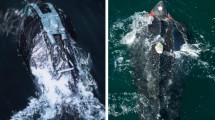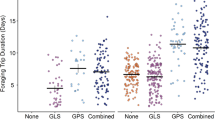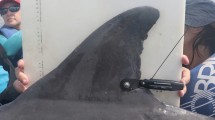Abstract
Small solar-powered satellite transmitters and GPS data loggers enable continuous, multi-year, and global tracking of birds. What is lacking, however, are reliable methods to attach these tracking devices to small migratory birds so that (1) flight performance is not impacted and (2) tags are retained during periods of substantial mass change associated with long-distance migration. We developed a full-body harness to attach tags to Red Knots (Calidris canutus), a medium-sized shorebird (average mass 124 g) that undertakes long-distance migrations. First, we deployed dummy tags on captive birds and monitored them over a complete migratory fattening cycle (February–July 2013) during which time they gained and lost 31–110 g and underwent a pre-alternate moult of body feathers. Using each individual’s previous year fattening and moult data in captivity as controls, we compared individual mass and moult differences between years between the tagged and reference groups, and concluded that the attachment did not impact mass and moult cycles. However, some birds shed feathers under the tags and under the polyester harness line commonly used in avian harnesses. Feather shedding was alleviated by switching to smoothed-bottom tags and monofilament harness lines. To field-trial this design, we deployed 5-g satellite transmitters on ten Red Knots released on 3 October 2013 in the Dutch Wadden Sea. Bird movements and tag performance appeared normal. However, nine tags stopped transmitting 11–170 days post-release which was earlier than expected. We attribute this to bird mortality rather than failure of the attachments or transmitters and suggest that the extra weight and drag caused by the tag and its feather-blocking shield increased the chance of depredation by the locally common Peregrine Falcons (Falco peregrinus). Our results demonstrate that species- and place-specific contexts can strongly determine tagging success. While captive trials are an important first step in developing an attachment method, field trials are essential to fully assess attachment designs.
Zusammenfassung
Test einer Befestigungsmethode für solargetriebene Peilsender bei einem langstreckenziehenden Watvogel
Kleine solargetriebene Satellitensender und GPS-Datenlogger ermöglichen das kontinuierliche und globale Verfolgen von Vögeln über mehrere Jahre. Was jedoch fehlt sind verlässliche Methoden, die Geräte an kleinen Zugvögeln zu befestigen, so dass (1) die Flugleistung nicht beeinträchtigt wird und (2) die Geräte in Zeiten erheblicher Körpermasseschwankungen, wie sie während des Langstreckenzuges auftreten, befestigt bleiben. Wir haben ein Ganzkörpergeschirr entwickelt, um Geräte am Knutt (Calidris canutus), einem mittelgroßen langstreckenziehenden Watvogel (durchschnittliche Köpermasse 124 g), zu befestigen. Zunächst haben wir Geräteattrappen bei in Gefangenschaft gehaltenen Vögeln eingesetzt und die Tiere über einen gesamten Zugzyklus hinweg beobachtet (Februar bis Juli 2013). In diesem Zeitraum gewannen und verloren sie 31–110 g an Masse und machten eine Pränuptialmauser der Körperfedern durch. Für jedes Individuum verwendeten wir die in Gefangenschaft gewonnenen Daten zu Fettreserven und Mauser aus dem vorherigen Jahr als Kontrolldaten und verglichen dann die individuellen Köpermasse- und Mauserunterschiede zwischen den Jahren von besenderten Tieren und unbesenderten Referenztieren. Wir fanden keinen Einfluss auf Körpermasse- und Mauserzyklen. Einige Tiere verloren allerdings Federn unter den Geräten und unter den bei Vögeln üblicherweise verwendeten Polyester-Geschirrschnüren. Der Federverlust wurde durch das Verwenden von Geräten mit glatter Unterseite und Monofilament-Geschirrschnüren gemindert. Um dieses Design im Freiland zu testen, statteten wir zehn Knutts mit 5 g schweren Satellitensendern aus und ließen sie am 3. Oktober 2013 im niederländischen Wattenmeer frei. Die Bewegungen der Vögel und die Geräteleistung erschienen normal. Neun Sender stellten allerdings das Senden 11–170 Tage nach der Freilassung der Tiere ein, was früher als erwartet war. Wir führen dies nicht auf das Versagen der Sender oder ihrer Befestigung zurück. Vielmehr vermuten wir eine höhere Mortalität der Vögel aufgrund einer durch das zusätzlich Gewicht und den zusätzlichen Luftwiderstandes durch das Gerät sowie dessen die Federn abdeckenden Schirm erhöhten Prädation durch den lokal häufigen Wanderfalken (Falco peregrinus). Unsere Ergebnisse zeigen, dass der art- und ortsspezifische Kontext den Besenderungserfolg deutlich beeinflussen kann. Während Vorversuche an in Gefangenschaft gehaltenen Vögeln einen wichtigen ersten Schritt beim Entwickeln einer Befestigungsmethode darstellen, sind Freilandversuche essenziell, um Befestigungsdesigns vollständig zu beurteilen.




Similar content being viewed by others
References
Barron DG, Brawn JD, Weatherhead PJ (2010) Meta-analysis of transmitter effects on avian behaviour and ecology. Methods Ecol Evol 1:180–187. doi:10.1111/j.2041-210X.2010.00013.x
Battley PF, Rogers DI, van Gils JA, Piersma T, Hassell CJ, Boyle A, Yang HY (2005) How do Red Knots Calidris canutus leave Northwest Australia in May and reach the breeding grounds in June? Predictions of stopover times, fuelling rates and prey quality in the Yellow Sea. J Avian Biol 36:494–500. doi:10.1111/j.0908-8857.2005.03730.x
Bouten W, Baaij EW, Shamoun-Baranes J, Camphuysen CJ (2013) A flexible GPS tracking system for studying bird behaviour at multiple scales. J Ornithol 154:571–580. doi:10.1007/s10336-012-0908-1
Brander RB (1968) A radio-package harness for game birds. J Wildl Manag 32:630–632
Bridge ES, Thorup K, Bowlin MS, Chilson PB, Diehl RH, Fléron RW, Hartl P, Kays R, Kelly JF, Robinson DW, Wikelski M (2011) Technology on the move: recent and forthcoming innovations for tracking migratory birds. Bioscience 61:689–698. doi:10.1525/bio.2011.61.9.7
CLS (2015) Argos User’s Manual http://www.argos-system.org/manual/. Accessed 29 Mar 2015
Cohen JB, Karpanty SM, Fraser JD, Truitt BR (2007) Initial deployment tests of tiny PTTs on the Red Knot (Calidris canutus rufa). Microwave Telemetry Newsletter Tracker News 8:2. http://www.microwavetelemetry.com/uploads/newsletters/winter07page2.pdf. Accessed 24 Mar 2015
Fuller MR, Seegar WS, Schueck LS (1998) Routes and travel rates of migrating peregrine falcons Falco peregrinus and Swainson’s hawks Buteo swainsoni in the Western Hemisphere. J Avian Biol 29:433–440
Hake M, Kjellén N, Alerstam T (2001) Satellite tracking of Swedish Ospreys Pandion haliaetus: autumn migration routes and orientation. J Avian Biol 32:47–56. doi:10.1034/j.1600-48X.2001.320107.x
Hooijmeijer JCEW, Gill RE Jr, Mulcahy DM, Tibbitts TL, Kentie R, Gerritsen GJ, Bruinzeel LW, Tijssen DC, Harwood CM, Piersma T (2014) Abdominally implanted satellite transmitters affect reproduction and survival rather than migration of large shorebirds. J Ornithol 155:447–457. doi:10.1007/s10336-013-1026-4
Kenward RE (2001) A manual of wildlife radio tagging. Academic Press, London
Kesler DC, Raedeke AH, Foggia JR, Beatty WS, Webb EB, Humburg DD, Naylor LW (2014) Effects of satellite transmitters on captive and wild Mallards. Wildl Soc Bull 38:557–565. doi:10.1002/wsb.437
Klaassen RHG, Reneerkens J (2014) An overview of bird tracking studies in The Netherlands. Limosa 87:58–73
Klaassen RHG, Strandberg R, Hake M, Olofsson P, Tøttrup AP, Alerstam T (2010) Loop migration in adult Marsh Harriers Circus aeruginosus, as revealed by satellite telemetry. J Avian Biol 41:200–207. doi:10.1111/j.1600-048X.2010.05058.x
Klaassen RHG, Ens BJ, Shamoun-Baranes J, Exo K-M, Bairlein F (2012) Migration strategy of a flight generalist, the Lesser Black-backed Gull Larus fuscus. Behav Ecol 23:58–68. doi:10.1093/beheco/arr150
Nebel S, Piersma T, Van Gils JA, Dekinga A, Spaans B (2000) Length of stopover, fuel storage and a sex-bias in the occurrence of Red Knots Calidris c. canutus and C. c. islandica in the Wadden Sea during southward migration. Ardea 88:165–176
Olson BE, Sullivan KA, Farmer AH (2014) Marbled godwit migration characterized with satellite telemetry. Condor 116:185–194. doi:10.1650/CONDOR-13-024.1
Page GW, Warnock N, Tibbitts TL, Jorgensen D, Hartman CA, Stenzel LE (2014) Annual migratory patterns of Long-billed Curlews in the American West. Condor 116:50–61. doi:10.1650/CONDOR-12-185-R2.1
Pennycuick CJ, Fast PLF, Ballerstaedt N, Rattenborg N (2012) The effect of an external transmitter on the drag coefficient of a bird’s body, and hence on migration range, and energy reserves after migration. J Ornithol 153:633–644. doi:10.1007/s10336-011-0781-3
Piersma T (2007) Using the power of comparison to explain habitat use and migration strategies of shorebirds worldwide. J Ornithol 148(Suppl. 1):S45–S59
Piersma T, Hoekstra R, Dekinga A, Koolhaas A, Wolf P, Battley PF, Wiersma P (1993) Scale and intensity of intertidal habitat use by Knots Calidris canutus in the western Wadden Sea in relation to food, friends and foes. Neth J Sea Res 31:331–357
Piersma T, Cadée N, Daan S (1995) Seasonality in basal metabolic rate and thermal conductance in a long-distance migrant shorebird, the Knot (Calidris canutus). J Comp Physiol B 165:37–45. doi:10.1007/bf00264684
Piersma T, Rogers DI, Gonzalez PM, Zwarts L, Niles LJ, de Nascimento ILS, Minton CDT, Baker AJ (2005) Fuel storage rates before northward flights in red knots worldwide: facing the severest ecological constraint in tropical intertidal environments? In: Greenberg R, Marra PP (eds) Birds of two worlds: ecology and evolution of migration. Johns Hopkins University Press, Baltimore, pp 262–273
Piersma T, Brugge M, Spaans B, Battley PF (2008) Endogenous circannual rhythmicity in body mass, molt, and plumage of great knots (Calidris tenuirostris). Auk 125:140–148
R Core Team (2013) R: A language and environment for statistical computing. R Foundation for Statistical Computing, Vienna, Austria. ISBN 3-900051-07-0. http://www.R-project.org/
Rakhimberdiev E, van den Hout PJ, Brugge M, Spaans B, Piersma T (2015) Seasonal mortality and sequential density dependence in a migratory bird. J Avian Biol 46:001–010. doi:10.1111/jav.00701
Rappole JH, Tipton AR (1991) New harness design for attachment of radio transmitters to small passerines. J Field Ornithol 62:335–337
Rogers DI, Battley PF, Piersma T, van Gils JA, Rogers KG (2006) High-tide habitat choice: insights from modelling roost selection by shorebirds around a tropical bay. Anim Behav 72:563–575. doi:10.1016/j.anbehav.2005.10.029
Roshier DA, Asmus MW (2009) Use of satellite telemetry on small-bodied waterfowl in Australia. Mar Freshw Res 60:299–305. doi:10.1071/MF08152
Sanzenbacher P, Haig SM, Oring LW (2000) Application of a modified harness design for attachment of radio transmitters to shorebirds. Wader Study Group Bull 91:16–20
Shamoun-Baranes J, Bouten W, Camphuysen CJ, Baaij E (2011) Riding the tide: intriguing observations of gulls resting at sea during breeding. Ibis 153(2):411–415. doi:10.1111/j.1474-919X.2010.01096.x
Spaans B, Brugge M, Dekinga A, Horn H, van Kooten L, Piersma T (2009) Space use of Red Knots Calidris canutus in the Dutch Wadden Sea. Limosa 82:113–121
Tomkiewicz SM, Fuller MR, Kie JG, Bates KK (2010) Global positioning system and associated technologies in animal behaviour and ecological research. Philos Trans R Soc Lond B 365:2163–2176. doi:10.1098/rstb.2010.0090
van den Hout PJ (2010) Struggle for Safety: Adaptive responses of wintering waders to their avian predators. PhD thesis, University of Groningen
van den Hout PJ, Mathot KJ, Maas LRM, Piersma T (2010) Predator escape tactics in birds: linking ecology and aerodynamics. Behav Ecol 21:16–25. doi:10.1093/beheco/arp146
van Gils J, Piersma T (1999) Day- and night-time movements of radiomarked Red Knots staging in the western Wadden Sea in July–August 1995. Wader Study Group Bull 89:36–44
van Gils JA, Dekinga A, Spaans B, Vahl WK, Piersma T (2005) Digestive bottleneck affects foraging decisions in Red Knots Calidris canutus. II. Patch choice and length of working day. J Anim Ecol 74:120–130. doi:10.1111/j.1365-2656.2004.00904.x
van Gils JA, Spaans B, Dekinga A, Piersma T (2006) Foraging in a tidally structured environment by Red Knots (Calidris canutus): ideal, but not free. Ecology 87:1189–1202. doi:10.1890/0012-9658(2006)87[1189:FIATSE]20.CO;2
Warnock N, Warnock S (1993) Attachment of radio-transmitters to sandpipers: review and methods. Wader Study Group Bull 70:28–30
Watts BD, Truitt BR, Smith FM, Mojica EK, Paxton BJ, Wilke AL, Duerr AE (2008) Whimbrel tracked with satellite transmitter on migratory flight across North America. Wader Study Group Bull 115:119–121
Acknowledgments
Bernard Spaans, Piet van den Hout, the crew of RV Navicula and many others have helped catching Red Knots. Edwin Keijzer designed and 3D-printed the dummy tags. John Cluderay suggested that heat-shrink tubing could be wrapped around the ‘breast knot’. The photo in Fig. 1b was by Jan van de Kam. We are grateful to Cathy Bykowsky and Paul Howey of Microwave Telemetry, Maryland, USA, for making their tags available in time for the field test. We thank Nanneke van der Wal and Chris Pool of the KNAW Animal Experiments Committee for their help. This study was supported by an NWO-ALW TOP-grant (‘Shorebirds in space’, 854.11.004, awarded to T.P.) with additional contributions from WWF-Netherlands, WWF-China and Waddenfonds (’Metawad’, WF-209925, awarded to T.P.). Any use of trade, firm, or product names is for descriptive purposes only and does not imply endorsement by the US Government.
Author information
Authors and Affiliations
Corresponding author
Ethics declarations
Conflict of interest
The authors declare that they have no conflict of interest.
Ethical approval
This study was carried out under protocol DEC-NIOZ 12.04 and DEC-NIOZ 13.01 approved by the Animal Experiments Committee under the Royal Netherlands Academy of Arts and Sciences (KNAW).
Additional information
Communicated by F. Bairlein.
Rights and permissions
About this article
Cite this article
Chan, YC., Brugge, M., Tibbitts, T.L. et al. Testing an attachment method for solar-powered tracking devices on a long-distance migrating shorebird. J Ornithol 157, 277–287 (2016). https://doi.org/10.1007/s10336-015-1276-4
Received:
Revised:
Accepted:
Published:
Issue Date:
DOI: https://doi.org/10.1007/s10336-015-1276-4




